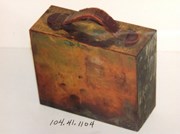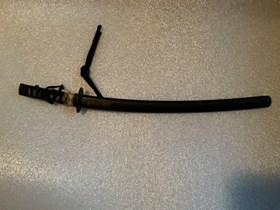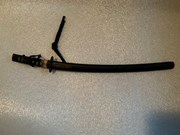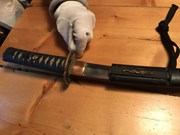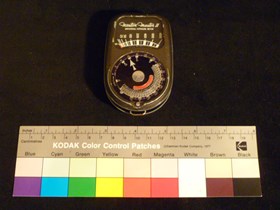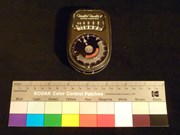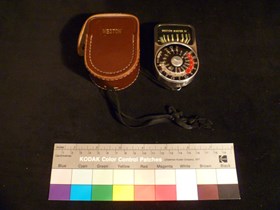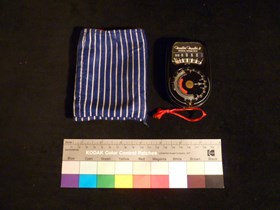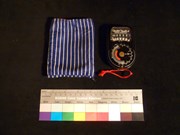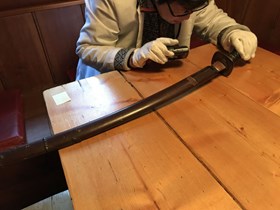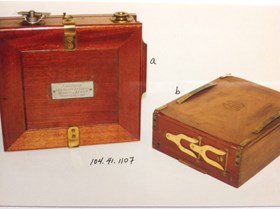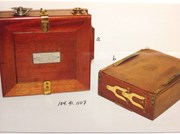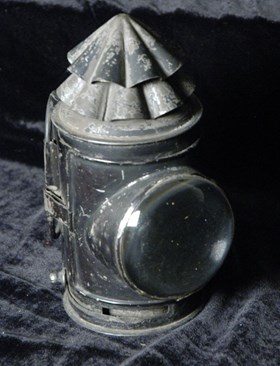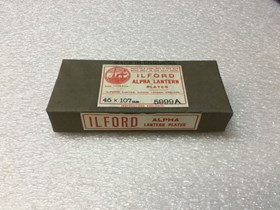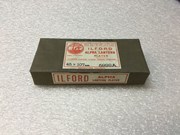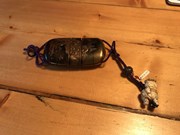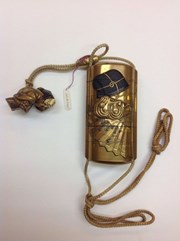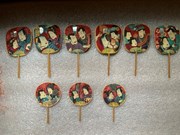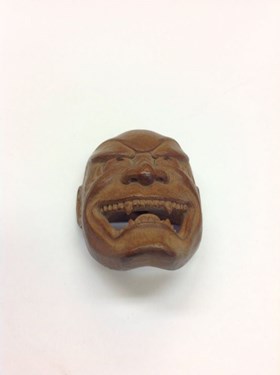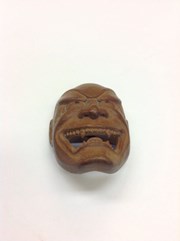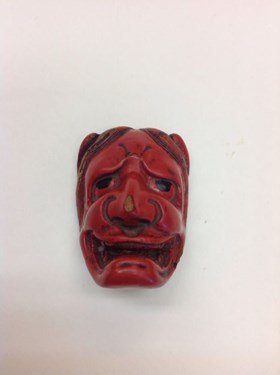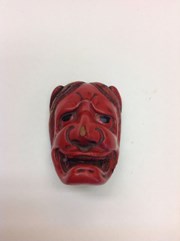Narrow Results By
Bric-A-Brac Stand Collection
https://archives.whyte.org/en/permalink/artifact102.04.0319%20a-f
- Date
- 1800 – 1890
- Material
- wood
- Catalogue Number
- 102.04.0319 a-f
- Description
- A collection of six short dark brown wooden stands. (a) 2.3 x 9.8 - incised double circle in circular platform top and carved knob trim around its rim. Outward bowed base is elaborately carved through in interwoven knot design between three square spiral motifs, each of which terminates in a small …
1 image
- Title
- Bric-A-Brac Stand Collection
- Date
- 1800 – 1890
- Material
- wood
- Dimensions
- 2.3 cm
- Description
- A collection of six short dark brown wooden stands. (a) 2.3 x 9.8 - incised double circle in circular platform top and carved knob trim around its rim. Outward bowed base is elaborately carved through in interwoven knot design between three square spiral motifs, each of which terminates in a small foot. Underside has circle carved at centre. (b) 2.6 x 5.8 - small lip around top platform, outward bowed base carved through in scrolled vine pattern between solid spaces terminating in three small feet. Marks: on base, red Japeanese writing) (c) 2.6 x 6.7 - double circle inscribed on top platform which is ringed with small lip, smooth outward bowed base with three small feet curving outward, small circle cut in base. Marks: on base, paper label, “605/2” (d) 2.7 x 6.5 - lathe turned with small lip around top platform, smooth outward bowed base with small foot-ring, bottom hollowed inside foot-ring. (e) 1.6 x 5.7 - small raised ring carved around platform top, base flares out slightly and is scroll-shaped along bottom defining three very small feet. (f) 1.6 x 4.5 - small lip around platform top, sharp shoulder of outward bowed based incised with small lines around; scroll carving at bottom defines small feet.
- Subject
- households
- decorative
- Japanese
- E. S. Morse;
- Credit
- Gift of Catharine Robb Whyte, O. C., Banff, 1979
- Catalogue Number
- 102.04.0319 a-f
Images
This material is presented as originally created; it may contain outdated cultural descriptions and
potentially offensive content.
Read more.
- Date
- 1885 – 1890
- Material
- wood; metal; skin
- Catalogue Number
- 104.41.1010 a,b
- Description
- “Premo D” folding camera (4”x5” format) with a leather covered wooden frame. The camera has a leather handle centred on the top and held in place with brass keepers. The hinged front of the camera opens to lie flat and has a brass track (3.2 cm wide) running down the centre. The red leather bell…
1 image
- Title
- Camera
- Date
- 1885 – 1890
- Material
- wood; metal; skin
- Dimensions
- 12.0 x 14.5 x 17.5 cm
- Description
- “Premo D” folding camera (4”x5” format) with a leather covered wooden frame. The camera has a leather handle centred on the top and held in place with brass keepers. The hinged front of the camera opens to lie flat and has a brass track (3.2 cm wide) running down the centre. The red leather bellows extend along the track and end with a wooden frame that holds a lens (missing) and a viewfinder. The camera also has hinged doors on the right side and on the back.b) Film plate holder loaded in the camera’s side chamber.
- Subject
- households
- photography
- hobbies
- Credit
- Gift of Unknown, 1968
- Catalogue Number
- 104.41.1010 a,b
Images
This material is presented as originally created; it may contain outdated cultural descriptions and
potentially offensive content.
Read more.
- Date
- 1883 – 1926
- Material
- cardboard; metal; glass;
- Catalogue Number
- 104.41.0129 a,b
- Description
- Two camera lenses housed in a repurposed Hammond box with “OLD ‘ADON’ Telephoto in shutter circa 1990’s” written in black ink on the front.The larger lens with shutter was manufactured by Bausch & Lomb Optical Co., originally a company that produced prescription eye-wear in the mid to late-1800s be…
1 image
- Title
- Camera Lenses
- Date
- 1883 – 1926
- Material
- cardboard; metal; glass;
- Dimensions
- 5.7 x 7.8 x 14.5 cm
- Description
- Two camera lenses housed in a repurposed Hammond box with “OLD ‘ADON’ Telephoto in shutter circa 1990’s” written in black ink on the front.The larger lens with shutter was manufactured by Bausch & Lomb Optical Co., originally a company that produced prescription eye-wear in the mid to late-1800s before expanding into camera lenses and microscopes/telescopes towards the turn of the century. The company was founded in Rochester NY.The smaller lens was manufactured by Gundlach-Manhattan Optical Co., a merged company between Gundlach Optical Co. and Manhattan Optical Co. that took place in 1902, which produced various kinds of bellows cameras. Both companies were based in Rochester NY prior to merging.
- Credit
- Gift of Nicholas Morant, Banff, 2006
- Catalogue Number
- 104.41.0129 a,b
Images
This material is presented as originally created; it may contain outdated cultural descriptions and
potentially offensive content.
Read more.
- Date
- 1995
- Material
- leather; metal; wood; plastic
- Catalogue Number
- 104.41.0081 a-d
- Description
- Case: Manufacturer label on inside of lid reads G.R. TAYLOR LTD. TRUNKS & SAMPLE CASES WINNIPEG. No manufacturer details available online. Case is triangular in shape with a central carrying handle and metal clasps located along the narrow upper edge - one side of the case folds down. Padded suppor…
1 image
- Title
- Camera Tripod
- Date
- 1995
- Material
- leather; metal; wood; plastic
- Dimensions
- 28.3 x 28.6 x 138.5 cm
- Description
- Case: Manufacturer label on inside of lid reads G.R. TAYLOR LTD. TRUNKS & SAMPLE CASES WINNIPEG. No manufacturer details available online. Case is triangular in shape with a central carrying handle and metal clasps located along the narrow upper edge - one side of the case folds down. Padded supports and buckled leather straps located inside to keep the tripod in place - straps not done up at time of processing. NICHOLAS MORANT written in white along the narrow top edge on either side of carrying handle, TR1 written in yellow paint in the top left end of narrow edge and in top right corner of opening side, the torn remains on a Canadian Pacific Railway label remains on the side that does not open. Tripod: Manufacturer mark on metal support below the camera support base reads [D]INEMA EQUIPMENT CO. No manufacturer details available online. Tripod dimensions are 124.1x14.7x14.7 cm. The legs of the tripod are wood, with metal spikes at the bottoms, metal brackets, and a metal camera support rig [possibly cast iron]. The legs are held together with a buckled strip of leather at the bottom. Also in the case is a metal pole with a black plastic handle that can screw into the camera support base for use as a controller and a plastic zip-lock baggie containing a length of chain with 4 metal clasps throughout 286.0 cm in length.
- Credit
- Gift of Nicholas Morant, Banff, 2006
- Catalogue Number
- 104.41.0081 a-d
Images
This material is presented as originally created; it may contain outdated cultural descriptions and
potentially offensive content.
Read more.
Cut-Film Holder
https://archives.whyte.org/en/permalink/artifact104.41.1104
- Date
- 1885 – 1900
- Material
- metal; skin
- Catalogue Number
- 104.41.1104
- Description
- Metal box with opening compartments and leather carrying handle marked “45”. “Pat. May 31. 87. Aug. 3. 90” stamped on top. Spring loaded film changing apparatus inside.
1 image
- Title
- Cut-Film Holder
- Date
- 1885 – 1900
- Material
- metal; skin
- Dimensions
- 4.5 x 11.5 cm
- Description
- Metal box with opening compartments and leather carrying handle marked “45”. “Pat. May 31. 87. Aug. 3. 90” stamped on top. Spring loaded film changing apparatus inside.
- Subject
- photography
- Vaux family
- Credit
- Gift of Molly Vaux, New York, USA, 1999
- Catalogue Number
- 104.41.1104
Images
This material is presented as originally created; it may contain outdated cultural descriptions and
potentially offensive content.
Read more.
Dirk; Scabbard Sword
https://archives.whyte.org/en/permalink/artifact104.05.0051%20a-c
- Date
- 1800 – 1880
- Material
- metal; wood; leather; skin; fibre; horn
- Catalogue Number
- 104.05.0051 a-c
- Description
- A Japanese samurai sword with black cord handle and black scabbard. (a) sword, long curved steel blade connected at hilt with brass to wooden handle covered with white pebbly sharkskin which shows through diamond shapes left open under silk cord which wraps handle. Metal band at base of hilt and me…
1 image
- Title
- Dirk; Scabbard Sword
- Date
- 1800 – 1880
- Material
- metal; wood; leather; skin; fibre; horn
- Dimensions
- 7.4 x 66.6 cm
- Description
- A Japanese samurai sword with black cord handle and black scabbard. (a) sword, long curved steel blade connected at hilt with brass to wooden handle covered with white pebbly sharkskin which shows through diamond shapes left open under silk cord which wraps handle. Metal band at base of hilt and metal cap at its end have relief casting of leaves and blossoms, and a bronze casting of blossoms is caught under black cord wrapping handle, oval sword guard has cut out relief of branches and blossoms, with holes on either side large enough to allow dirk to pass through. (b) dirk, long thin blade set into brass handle with cast relief of heron standing in stream with incised bushes around. Japanese calligraphy on other side of handle. (c) scabbard, slightly curved to fit blade. Wood covered with fine grained leather with narrow black band, horn? at mouth and another at top of slit pocket where dirk slides in. Pocket groove on one side near top to accommodate dirk, and semi-circular black piece of carved horn on opposite side, threaded through with flat braided black silk cord to tie scabbard to belt
- Credit
- Gift of Catharine Robb Whyte, O. C., Banff, 1979
- Catalogue Number
- 104.05.0051 a-c
Images
This material is presented as originally created; it may contain outdated cultural descriptions and
potentially offensive content.
Read more.
Dirk; Scabbard Sword
https://archives.whyte.org/en/permalink/artifact104.05.0061%20a-c
- Date
- 1800 – 1880
- Material
- metal; wood; fibre; enamel; skin
- Catalogue Number
- 104.05.0061 a-c
- Description
- Japanese samurai sword with blue silk cord wrapped handle and black enamelled scabbard: (a) sword, long, slightly curved, steel blade joined to hilt with wide copper band. Wooden handle wrapped with blue silk cord with pebbly white sharkskin showing through diamond-shaped openings in wrapping. Meta…
1 image
- Title
- Dirk; Scabbard Sword
- Date
- 1800 – 1880
- Material
- metal; wood; fibre; enamel; skin
- Dimensions
- 6.7 x 6.0 x 54.5 cm
- Description
- Japanese samurai sword with blue silk cord wrapped handle and black enamelled scabbard: (a) sword, long, slightly curved, steel blade joined to hilt with wide copper band. Wooden handle wrapped with blue silk cord with pebbly white sharkskin showing through diamond-shaped openings in wrapping. Metal cap at end of handle with relief of squatting figure reading scroll. Small cast figures of two deer caught beneath cord on either side of handle. Metal band at base of handle with relief of gilded figure in reed boat. Rectangular sword guard with cast relief of chrysanthemums and butterfly with holes cut through each side to accommodate small dirk handle. (b) dirk, steel bladed with copper handle with relief casting of brass dragon on one side. (c) scabbard, slightly curved wood covered with black enamel containing green flecks, blunt end, top of scabbard has slot on one side leading to pocket in scabbard to accommodate small dirk. Opposite side from slot has semi-circular horn ? lug threaded with a length of black silk cord. Note: small band at top of dirk pocket missing, enamel cracked and peeling in many places, especially near top, semi-circular lug loose.
- Credit
- Gift of Catharine Robb Whyte, O. C., Banff, 1979
- Catalogue Number
- 104.05.0061 a-c
Images
This material is presented as originally created; it may contain outdated cultural descriptions and
potentially offensive content.
Read more.
Exposure Meter
https://archives.whyte.org/en/permalink/artifact104.41.1118
- Date
- 1888
- Material
- metal; paint; plastic
- Catalogue Number
- 104.41.1118
- Description
- Hand held exposure/light meter made by Weston Electrical Instrument Company in a grey metal finish. Along both sides of the meter are a series of protruding lines that allow one to safely grip the object. At the bottom of the artifact there is a metal hook, which would have allowed a string to be a…
1 image
- Title
- Exposure Meter
- Date
- 1888
- Material
- metal; paint; plastic
- Dimensions
- 2.0 x 6.0 x 9.5 cm
- Description
- Hand held exposure/light meter made by Weston Electrical Instrument Company in a grey metal finish. Along both sides of the meter are a series of protruding lines that allow one to safely grip the object. At the bottom of the artifact there is a metal hook, which would have allowed a string to be attached like on the other Weston meter’s owned by Nicholas. There is also no longer a case to protect this particular object. In the top of the exposure meter there is a clear plastic covering. Along the very top there us the name of the manufacturer in white cursive lettering that reads “Weston Master II” and written underneath in capital letters “UNIVERSAL EXPOSURE METER.” Below this is the light scale where the value of the scene would be indicated. The scale contains the values “0” “25” “50” “100” “200” “400” “800” “1600,” which means that the two values on this instrument are calibrated 0-50 and 0-1600. (candles per square foot.)Below there is a circular face with several figures and a dial that turns/rotates. The outside row of figures on the exposure control dial represents the light value settings and corresponds to the light values on the light scale. Below the round dial there is a tiny circular button that is used to set the exposure control dial for film speed. As the dial turns it reveals the “EMULSION SPEED” with a red baize finish that has become worn throughout its life. The row of figures at the bottom of the top dial is the f/stop values and has an “f” to make this more apparent for the user. The row of figures directly below the f/stop settings are the shutter speeds. After setting the exposure control dial to the light value obtained on the light scale, any of the combinations of f/stop and shutter speed directly opposite each other are correct. On the rear of the meter there is a black plastic covering that contains several circular cut outs that are called a hir.ged baffle. This can be swung open (against the case) using the gold latch, which clips into a tiny hole or socket when the user wishes it to be closed. When opened the light sensitive photo cell is directly beneath this baffle and contains several protruding circles. When the baffle is open, the scale range is 0-50; when the baffle is closed, the scale range is 0-1600. Below there is an oval shaped face with extensive information that is held in place with two small screws on both the viewer left and right side. There is silver lettering on a black background that reads “WESTON ELEC. INST. CORP.” “NEWARK, N.J., U.S.A.” A silver backing separates the patent information and has black writing that reads “MODEL 735” on the viewer left side. On the viewer right side the number “7454510” is engraved. In the middle there is a gold-coloured screw with the words “ZERO CORRECTOR” written in black. Below this there is the patent information; “U.S. PATENTS” “2,274,441” “2,073,790” “2,346,555” “2,137,466” “2,463,770.” Below these numbers are the “FOREIGN PATENTS” “FRENCH 862,770” “BRITISH 531,996” “CAN. 347,085” “CAN. 411,975” At the very bottom underneath there is the manufacturer’s location; “MADE IN U.S.A.”
- Subject
- photography
- Nick Morant
- Credit
- Gift of Nicholas Morant, Banff, 2006
- Catalogue Number
- 104.41.1118
Images
This material is presented as originally created; it may contain outdated cultural descriptions and
potentially offensive content.
Read more.
- Date
- 1888
- Material
- leather; metal; nylon; plastic; thread; paint
- Catalogue Number
- 104.41.1119 a-b
- Description
- Hand held light meter in a pear shape with a stainless steel body and leather case. Along both sides of the meter are a series of protruding lines that allow one to safely grip the object. On the viewer right there is a pointer lock, which is locked when positioned upwards and released when positio…
1 image
- Title
- Exposure Meter
- Date
- 1888
- Material
- leather; metal; nylon; plastic; thread; paint
- Dimensions
- 2.0 x 5.0 x 9.0 cm
- Description
- Hand held light meter in a pear shape with a stainless steel body and leather case. Along both sides of the meter are a series of protruding lines that allow one to safely grip the object. On the viewer right there is a pointer lock, which is locked when positioned upwards and released when positioned downward. At the bottom of the artifact there is a metal hook, which has a black string running through. In the top of the light meter there is clear plastic covering. Written in capital letters is “WESTON MATER IV” above the light scale. The lights scale contains the numbers “0” “25” “50” “100” “200” “400” “800” “1600,” which means that the 2 values calibrated on this instrument are 0-50 and 0-1600.Below there is another light scale in the form of a circular face with several figures and a dial that turns/rotates. The dial on the outside has a series of protruding lines to make movement easier and contains a row of figures. This dial controls the lens aperture (f/stop) scale and has a series of values representing the focal length of the lens; “1” “1.4” “2” “2.8” “4” “5.6”. On the same dial there is also the letters “EVS,” which stands for the exposure value setting with a cut out window that reveals the EVS values. Working in a clockwise direction (on the same dial) there is also the letters “U,” “A with “1/2” over top,” an enclosed arrow that is known as the normal arrow, a “C” with “2x” on top of it, and a “0”. As this dial is turned it reveals a partly red baize and black numbers on a silver background that represents the shutter speeds in fractions of seconds. The inside dial has a series of light scale values and an exposure index window that line up with the “U,” “A,” normal arrow, “C,” and “0.” On the opposite side of the exposure index window is the exposure index knob. On the rear of the meter there is a black plastic covering that contains several circular cut outs that are called a hir.ged baffle. This can be swung open (against the case) using the gold latch, which clips into a tiny hole or socket when the user wishes it to be closed. When opened the light sensitive photo cell is directly beneath this baffle and contains several protruding circles. When the baffle is open, the scale range is 0-50; when the baffle is closed, the scale range is 0-1600. Below there is an oval shaped face with extensive information that is held in place with two small screws on both the viewer left and right side. There is black lettering on a silver background that reads “UNIVERSAL EXPOSURE METER” “MODEL 745” SER.W” and “107522” engraved. Below the manufacturer information is listed; “DAYSTROM. INCORPORATED” “WESTON INSTRUMENTS DIVISION”. “NEWARK. N.J.. U.S.A.” In the middle there is a gold-coloured screw with the words “ZERO CORRECTOR” written in black. On the viewer left side of the zero corrector there is patent information; “U.S. PATENTS” “2463770” and on the viewer right side “FOREIGN PATS” “CAN. 411975”. At the very bottom on either side of a circular cut out are “ASA” and “K=1.0” written. Underneath “MADE IN JAPAN” has also been written.There is also a brown leather case with this object. The front has “WESTON” written in gold letters. On the viewer left there is a brown button that allows the case to be opened or fastened shut. The leather has been stitched together with light brown thread that is visible. The bottom of the case has an opening for the black string to be strung through so that the light meter and case are attached. On the rear there is a brown leather strap stitched.
- Subject
- photography
- Nick Morant
- Credit
- Gift of Nicholas Morant, Banff, 2006
- Catalogue Number
- 104.41.1119 a-b
Images
This material is presented as originally created; it may contain outdated cultural descriptions and
potentially offensive content.
Read more.
- Date
- 1888
- Catalogue Number
- 104.41.1120 a-b
- Description
- Hand held light meter in a pear shape with a stainless steel body and leather case. Along both sides of the meter are a series of protruding lines that allow one to safely grip the object. At the bottom of the artifact there is a metal hook, which has a red string running through.There is a clear p…
1 image
- Title
- Exposure Meter
- Date
- 1888
- Description
- Hand held light meter in a pear shape with a stainless steel body and leather case. Along both sides of the meter are a series of protruding lines that allow one to safely grip the object. At the bottom of the artifact there is a metal hook, which has a red string running through.There is a clear plastic covering located at the top of the meter. Written in cursive letters is the company name “WESTON MATER II”. Underneath this written in capital letters is “UNIVERSAL EXPSOURE METER”. The light scale underneath contains the numbers “0” “25” “50” “100” “200” “400” “800” “1600,” which means that the 2 values calibrated on this instrument are 0-50 and 0-1600. Underneath the scale the word “Light” is present. Below there is another light scale in the form of a circular face with several figures and a dial that turns/rotates. The outside row of figures on the exposure control dial represents the light value settings and corresponds to the light values on the light scale at the top. The row of figures at the bottom of the top dial is the f/stop values and has an “f” to make this more apparent for the user.. On the same dial there is silver letters that have a line that correspond to the figures on the outside dial; “U,” “A with “1/2” underneath,” an arrow that is known as the normal arrow, a “C” with “2x” below it, and a “0”. As this dial is turned it reveals a partly red baize and the emulsion speed, which is self-evident as the words “EMULSION SPEED” are present. The row of figures directly below the f/stop settings are the shutter speeds. The outside row of figures is the light values, which is apparent as the word “LIGHT” with an arrow points to these values. After setting the exposure control dial to the light value obtained on the light scale, any of the combinations of f/stop and shutter speed directly opposite each other are correct. Below the round dial there is a tiny circular button that is used to set the exposure control dial for film speed.On the rear of the meter there is a black plastic covering that contains several circular cut outs that are called a hir.ged baffle. This can be swung open (against the case) using the gold latch, which clips into a tiny hole or socket when the user wishes it to be closed. When opened the light sensitive photo cell is directly beneath this baffle and contains several protruding circles. When the baffle is open, the scale range is 0-50; when the baffle is closed, the scale range is 0-1600. Below there is an oval shaped face with extensive information that is held in place with two small screws on both the viewer left and right side. There is silver lettering on a black background that reads “WESTON ELEC. INST. CORP.” “NEWARK, N.J., U.S.A.” A silver backing separates the patent information and has black writing that reads “MODEL 735” on the viewer left side; “No” is present in the middle; “8284703” is engraved on the viewer right side. In the middle there is a brass screw with the words “ZERO CORRECTOR” written in black around its circumference. On the viewer left side of the zero corrector is the patent information; “U.S. PATENTS” “1,779,574” “1,982,406” “2,073,790” and on the viewer right side continued patent information “U.S. PATENTS” “2,137,466” “2,274,441” “2,346,555”. Below these numbers are the “FOREIGN PATENTS” “FRENCH 862,770” “BRITISH 531,996” “CAN. 347,085” “CAN. 411,975” At the very bottom underneath there is the manufacturer’s location; “MADE IN U.S.A.” written in black on a silver background.There is also a blue case with white stripes and a red inner lining that would be used to protect the case. This would not have been originally sold with the exposure meter and was most likely hand made in an effort to protect the meter. Blue stitches hold the fabric together and are visible.
- Subject
- photography
- Nick Morant
- Credit
- Gift of Nicholas Morant, Banff, 2006
- Catalogue Number
- 104.41.1120 a-b
Images
This material is presented as originally created; it may contain outdated cultural descriptions and
potentially offensive content.
Read more.
- Date
- 1800 – 1900
- Material
- metal; skin; fibre
- Catalogue Number
- 104.05.0048 a-c
- Description
- A Japanese samurai sword with dirk and brown scabbard. (a) sword, long curved steel blade attached by brass collar to hilt. Handle of wood with pebbled texture of sharkskin applied and showing through diamond shaped openings left in decorative wrapping with leather strips over handle. Metal cap at…
1 image
- Title
- Fighting Sword
- Date
- 1800 – 1900
- Material
- metal; skin; fibre
- Dimensions
- 7.0 x 6.5 x 72.1 cm
- Description
- A Japanese samurai sword with dirk and brown scabbard. (a) sword, long curved steel blade attached by brass collar to hilt. Handle of wood with pebbled texture of sharkskin applied and showing through diamond shaped openings left in decorative wrapping with leather strips over handle. Metal cap at end of handle has low relief casting of gilded dragonfly on one corner, a small bronze insect is caught below the leather wrapping on either side of the handle. Rectangular sword guard at hilt has incised design and vestiges of gold painted design with a decorative opening either side. (b) dirk, short narrow blade set into metal handle with inlay of bronze in shape of stem with leaves and two seed pods on one side, fits into slit in top of scabbard. Note: part of inlay missing. (c) scabbard, hollow wood shaped to fit the blade and covered with finely textured brown leather. Slots on either side near hilt are banded at top with smooth black strip, wood?, horn?, and further down as well, where dirk enters. Ornate metal cap at tip extends in a strip 16.0 cm along back edge and 5.0 cm along front edge with narrow metal band around scabbard 10.0 cm from tip. Small gilded dragonfly on one corner of cap at tip.
- Credit
- Gift of Catharine Robb Whyte, O. C., Banff, 1979
- Catalogue Number
- 104.05.0048 a-c
Images
This material is presented as originally created; it may contain outdated cultural descriptions and
potentially offensive content.
Read more.
- Date
- 1885 – 1900
- Material
- wood; metal
- Catalogue Number
- 104.41.1107 a,b
- Description
- (a) Wooden film roller with brass fittings. Metal plate on top reads: “EASTMAN DRY PLATE & FILM CO. Rochester, N.Y., U.S.A. PATENTED MAY 5, 1885.” (b) Wooden film roller with brass fittings, top stamped: “EASTMAN KODAK CO. PAT. MAY 5, 1885. OTHER PATENTS APPL’D FOR IN ALL COUNTRIES.”
1 image
- Title
- Film Roller
- Date
- 1885 – 1900
- Material
- wood; metal
- Dimensions
- 6.0 x 18.0 cm
- Description
- (a) Wooden film roller with brass fittings. Metal plate on top reads: “EASTMAN DRY PLATE & FILM CO. Rochester, N.Y., U.S.A. PATENTED MAY 5, 1885.” (b) Wooden film roller with brass fittings, top stamped: “EASTMAN KODAK CO. PAT. MAY 5, 1885. OTHER PATENTS APPL’D FOR IN ALL COUNTRIES.”
- Subject
- photography
- Vaux family
- Credit
- Gift of Molly Vaux, New York, USA, 1999
- Catalogue Number
- 104.41.1107 a,b
Images
This material is presented as originally created; it may contain outdated cultural descriptions and
potentially offensive content.
Read more.
Kerosene Lantern
https://archives.whyte.org/en/permalink/artifact102.05.1018
- Date
- 1880 – 1885
- Material
- metal; glass
- Catalogue Number
- 102.05.1018
- Description
- Black metal lantern with large glass lens in opening door. Inside is a removable fuel reservoir with knob to adjust wick. Sliding screen controls amount of light. “Private Property. VAUX 84” scratched into base of lantern.
1 image
- Title
- Kerosene Lantern
- Date
- 1880 – 1885
- Material
- metal; glass
- Dimensions
- 17.0 x 9.0 cm
- Description
- Black metal lantern with large glass lens in opening door. Inside is a removable fuel reservoir with knob to adjust wick. Sliding screen controls amount of light. “Private Property. VAUX 84” scratched into base of lantern.
- Subject
- photography
- Vaux family
- camping
- hiking
- Credit
- Gift of Molly Vaux, New York, USA, 1999
- Catalogue Number
- 102.05.1018
Images
This material is presented as originally created; it may contain outdated cultural descriptions and
potentially offensive content.
Read more.
Lantern Plates
https://archives.whyte.org/en/permalink/artifact104.41.0206
- Date
- 1889 – 1910
- Material
- paper; glass;
- Catalogue Number
- 104.41.0206
- Description
- One paper-wrapped package of 45x107mm Ilford Alpha Lantern Plates with white and red paper adhesive labels on the top and front of the package containing manufacturer details. These lantern plates would serve as the positive mount for the lantern slide made from the original negative. Lantern slide…
1 image
- Title
- Lantern Plates
- Date
- 1889 – 1910
- Material
- paper; glass;
- Dimensions
- 2.0 x 11.6 x 5.3 cm
- Description
- One paper-wrapped package of 45x107mm Ilford Alpha Lantern Plates with white and red paper adhesive labels on the top and front of the package containing manufacturer details. These lantern plates would serve as the positive mount for the lantern slide made from the original negative. Lantern slides are glass-based transparencies that were displayed by being projected through an early projector called a magic lantern. Starting as hand-painted images on glass, lantern slides quickly adapted to first black-and-white and then colour photography and faded from popularity with the rise of celluloid film and motion pictures.
- Credit
- Gift of Robert Crosby Family, Banff, 1998
- Catalogue Number
- 104.41.0206
Images
This material is presented as originally created; it may contain outdated cultural descriptions and
potentially offensive content.
Read more.
- Date
- 1800 – 1890
- Material
- ivory; wood; fibre; metal
- Catalogue Number
- 103.08.0284
- Description
- The case is in five segments which are both held together and can be separated by tension of the purple cord. Cord extends from a hole on either extremity of segments rim edges, through to attach itself to the ivory netsuke. Netsuke is woman supporting small child on her back at left shoulder, woma…
1 image
- Title
- Medicine Case
- Date
- 1800 – 1890
- Material
- ivory; wood; fibre; metal
- Dimensions
- 2.2 x 5.7 x 9.3 cm
- Description
- The case is in five segments which are both held together and can be separated by tension of the purple cord. Cord extends from a hole on either extremity of segments rim edges, through to attach itself to the ivory netsuke. Netsuke is woman supporting small child on her back at left shoulder, woman wearing kimono, obi and getas. Signature on woman's right leg. Cord hole found on woman's left hip. Round filigree brass button slides on cord between netsuke and inro. Lacquer design on inro is landscape with birds on one side. Obverse is harbour scene with lighthouse boats and full moon, all in gold and black lacquer.
- Credit
- Gift of Catharine Robb Whyte, O. C., Banff, 1979
- Catalogue Number
- 103.08.0284
Images
This material is presented as originally created; it may contain outdated cultural descriptions and
potentially offensive content.
Read more.
- Date
- 1800 – 1890
- Material
- wood; ivory; metal; fibre
- Catalogue Number
- 103.08.0285
- Description
- Case is in six segments held together cord. Cord extends through holes on either extremity of rim edge and extends about 6 inches , 15 cm. to netsuke. On one face of case gold ground, mask and fan and a black lacquer bundle. Obverse has gold ground including sashes and black mask and gold and black…
1 image
- Title
- Medicine Case
- Date
- 1800 – 1890
- Material
- wood; ivory; metal; fibre
- Dimensions
- 4.6 x 2.5 x 9.3 cm
- Description
- Case is in six segments held together cord. Cord extends through holes on either extremity of rim edge and extends about 6 inches , 15 cm. to netsuke. On one face of case gold ground, mask and fan and a black lacquer bundle. Obverse has gold ground including sashes and black mask and gold and black striped cap. Embossed signature on bottom of inro. Toggle of brass filigree between inro and netsuke acts as a slide to tighten cord. Netsuke is an elderly, stooped man with long beard, wearing a mask. Mask and feet made of ivory but right foot is missing. Kimono gold and orange lacquer with hood of gold and black lacquer stripes. Ivory head loosening.
- Credit
- Gift of Catharine Robb Whyte, O. C., Banff, 1979
- Catalogue Number
- 103.08.0285
Images
This material is presented as originally created; it may contain outdated cultural descriptions and
potentially offensive content.
Read more.
- Date
- 1800 – 1890
- Material
- wood
- Catalogue Number
- 103.08.0286
- Description
- Tiny inro, missing cord through rim holes, to which netsuke would be attached. Three segments, gold on gold floral lacquer decoration.
1 image
- Title
- Medicine Case
- Date
- 1800 – 1890
- Material
- wood
- Dimensions
- 3.7 x 1.5 x 2.4 cm
- Description
- Tiny inro, missing cord through rim holes, to which netsuke would be attached. Three segments, gold on gold floral lacquer decoration.
- Subject
- households
- miniatures
- Japanese
- Edward S. Morse
- Credit
- Gift of Catharine Robb Whyte, O. C., Banff, 1979
- Catalogue Number
- 103.08.0286
Images
This material is presented as originally created; it may contain outdated cultural descriptions and
potentially offensive content.
Read more.
Miniature Fan Collection
https://archives.whyte.org/en/permalink/artifact103.08.0299%20a-i
- Date
- 1880 – 1900
- Material
- paper; wood
- Catalogue Number
- 103.08.0299 a-i
- Description
- Eight small souvenir paper fans with thin bamboo handles. Red is most dominant colour on all fans. Fans (a-f) are palmate in shape while (g-i) are smaller and circular. All five have a little mirror placed upper left center, and a blue and yellow fan motif at the base where handle meets paper. (a) …
1 image
- Title
- Miniature Fan Collection
- Date
- 1880 – 1900
- Material
- paper; wood
- Dimensions
- 14.5 cm
- Description
- Eight small souvenir paper fans with thin bamboo handles. Red is most dominant colour on all fans. Fans (a-f) are palmate in shape while (g-i) are smaller and circular. All five have a little mirror placed upper left center, and a blue and yellow fan motif at the base where handle meets paper. (a) image of Japanese woman, bottom left, in 3/4 profile facing right, Japanese male, upper right, faces woman. Small mirror makes up one side of a suspended box. Both figures have bright red lips. (b) Male figure bottom left, looks upwards towards figure of Japanese woman, upper left. Mirror in shape of full moon in background is partially hidden by midground post bearing Japanese calligraphy. (c) Two Japanese males in 3/4 profile facing each other, dressed in official looking clothing. Both are mustached. Mirror appears as one side of street lantern in background. (d) Image of Japanese woman, upper right, looking left toward male who wields a fan in his right hand, the mirror is a part of fan. (e) image of two Japanese women bottom left, faces in 3/4 profile, man wearing helmet upper right. Half moon shaped mirror upper left. (f) Japanese woman lower left, in 3/4 profile. Man in upper right looking down. Mirror in upper left corner in shape of lantern. (g) Small round fan with scene painted on both sides. One side, similar to (a-d) shows male Japanese figure looking right toward female figure, upperight. Small mirror hangs on stand, upper right center. On reverse is red circle with blue, white, and purple cloud like background above yellow fan shape. . Green calligraphy, left center, framed by three consecutive frames. (h) small round fan with scene painted on both sides. On front is similar design to (b) with male figure looking up towards female figure. Round mirror. Same design on back as (g). (i) small round fan with small square mirror and man in lower left corner looking up at woman.
- Credit
- Gift of Catharine Robb Whyte, O. C., Banff, 1979
- Catalogue Number
- 103.08.0299 a-i
Images
This material is presented as originally created; it may contain outdated cultural descriptions and
potentially offensive content.
Read more.
- Date
- 1800 – 1890
- Material
- wood
- Catalogue Number
- 103.08.0267
- Description
- Mask of man with wide grimace, medium brown hardwood. Concave back has carved calligraphy and a single hole through which a cord would pass.
1 image
- Title
- Netsuke
- Date
- 1800 – 1890
- Material
- wood
- Dimensions
- 2.4 x 4.3 x 5.3 cm
- Description
- Mask of man with wide grimace, medium brown hardwood. Concave back has carved calligraphy and a single hole through which a cord would pass.
- Subject
- Whyte home
- travel
- souvenir
- collectable
- keepsake
- households
- miniatures
- figure
- face
- Japanese
- E. S. Morse
- Credit
- Gift of Catharine Robb Whyte, O. C., Banff, 1979
- Catalogue Number
- 103.08.0267
Images
This material is presented as originally created; it may contain outdated cultural descriptions and
potentially offensive content.
Read more.
- Date
- 1800 – 1890
- Material
- wood
- Catalogue Number
- 103.08.0268
- Description
- Demon mask in red lacquer with black eyes, gold on nose and black interior at back of mask, where there is a single hole for cord passage. Red and white label on back saying "H.S 32", generally worn and soiled. Has been cracked and repaired lower left jaw, hairline crack lower right jaw, lacquer l…
1 image
- Title
- Netsuke
- Date
- 1800 – 1890
- Material
- wood
- Dimensions
- 2.1 x 3.0 x 3.9 cm
- Description
- Demon mask in red lacquer with black eyes, gold on nose and black interior at back of mask, where there is a single hole for cord passage. Red and white label on back saying "H.S 32", generally worn and soiled. Has been cracked and repaired lower left jaw, hairline crack lower right jaw, lacquer loss on right temple.
- Subject
- Whyte home
- travel
- souvenir
- keepsake
- collectable
- households
- miniatures
- figure
- face
- Japanese
- E. S. Morse
- Credit
- Gift of Catharine Robb Whyte, O. C., Banff, 1979
- Catalogue Number
- 103.08.0268
Images
This material is presented as originally created; it may contain outdated cultural descriptions and
potentially offensive content.
Read more.










